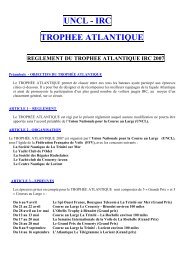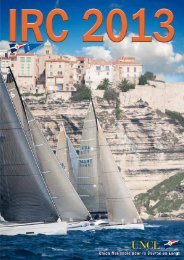Jean-Marie 2
IRC 2012 - UNCL
IRC 2012 - UNCL
- No tags were found...
You also want an ePaper? Increase the reach of your titles
YUMPU automatically turns print PDFs into web optimized ePapers that Google loves.
The Rule ■<br />
respect of crew number/weight limitations unless freed from this<br />
requirement by notice of race. See also Rule 13.7<br />
22.4.2 The Crew Number printed on each boat’s certificate shall<br />
not be exceeded or the crew weight shall not exceed 85kg<br />
multiplied by the Crew Number printed on the certificate.<br />
22.4.3 Rule 22.4 may be amended by Notice of Race.<br />
22.5 Crew Classification<br />
22.5.1 There are no rules on the classification of crew within IRC<br />
unless stated in a Notice of Race.<br />
23 SEAWORTHINESS AND SAFETY<br />
23.1 The issue of a rating certificate does not imply that a boat is<br />
necessarily of satisfactory design, safe or seaworthy. See Rule 3.<br />
23.2 Race committees may impose limits for race entry on<br />
safety grounds at their discretion. An SSS number, specific to the<br />
boat, and when data is available IRC/ISO STIX, AVS, and IRC/ISO<br />
Design Category will be printed on each boat's certificate for the<br />
guidance of owners and race organisers.<br />
24 DAYBOATS<br />
24.1 A Dayboat will be designated by “Dayboat”<br />
printed on the certificate.<br />
24.2 A Dayboat shall be self righting at 600 of heel.<br />
24.3 The following items shall be carried by a Dayboat when<br />
racing under IRC:<br />
24.3.1 A bilge pump and bucket.<br />
24.3.2 An engine or two paddles or a pair of oars.<br />
24.3.3 One anchor and suitable warp.<br />
24.3.4 A compass.<br />
24.3.5 One life jacket and whistle for each crew member.<br />
24.3.6 Two red hand flares.<br />
PART D / IRC, advertising not permitted<br />
25 RULES<br />
25.1 With the exception of Rule 16, Advertising, the IRC Rules<br />
Part C shall apply.<br />
26 ADVERTISING<br />
26.1 Competitors’ advertising displayed on hulls, spars and sails<br />
is restricted to advertising permitted by ISAF Regulation 20,<br />
Advertising Code, paragraph 20.7 only.<br />
Appendix 1 IRC MEASUREMENT DEFINITIONS<br />
and ABBREVIATIONS<br />
Measurement Note: ISAF Equipment Rules of Sailing (ERS)<br />
Part II, Definitions, shall apply to measurement except as<br />
stated by IRC Rules or this Appendix. Measurements shall be<br />
taken in accordance with ERS Part III, Measurement Rules,<br />
Section H.<br />
Terminology: A term used in its defined sense is printed in<br />
“bold” type if defined in the ERS. Any abbreviation given<br />
below is used in IRC Rules in its defined term unless<br />
specified otherwise.<br />
Age Date: The year in which the boat was first launched, or the<br />
year in which the boat was re-launched following hull<br />
modification, whichever is the later.<br />
Batten: Any material added to the sail, as either a removable<br />
element, permanent stiffening, or other contrivance, the purpose<br />
of which is to support and/or stiffen the sail.<br />
BO: The longitudinal distance between the foremost point on the<br />
hull and the foremost point of the waterline.<br />
Dayboat: A Dayboat is defined as a boat which cannot meet any<br />
of Categories 0 to 4 of the Offshore Special Regulations. The<br />
Rating Authority reserves the right to re-classify any boat without<br />
stating a reason.<br />
E: The outer point distance of a mainsail (or in the case of a<br />
schooner, a foremast sail). The outer limit mark shall be<br />
permanently marked by a 25mm band of contrasting colour. If<br />
there is no band the measurement shall be taken to the aft end<br />
of the boom.<br />
EY: The outer point distance of a mizzen (or in the case of a<br />
schooner, a mainsail). The outer limit mark shall be<br />
permanently marked by a 25mm band of contrasting colour. If<br />
there is no band the measurement shall be taken to the aft end<br />
of the boom.<br />
FL: The forestay length measured from the forward end of J to<br />
the forestay rigging point.<br />
Forestay: The ERS definition of forestay shall not apply.<br />
Forestay is defined as: Permanently attached rigging providing<br />
forward support for a mast spar.<br />
h: The vertical distance between the waterplane and the lowest<br />
point on the stem at a tangent of 450 to the longitudinal axis.<br />
Headsail: RRS 50.4 shall not apply. Any sail tacked down<br />
forward of the foremost mast which does not meet the<br />
definition of a spinnaker. A headsail may be hoisted from above<br />
the forestay rigging point.<br />
HHB: The widest top width of any headsail on board and which<br />
may be used while racing.<br />
HHW: The half width of the largest area headsail.<br />
HSA: The maximum permitted headsail area.<br />
HTW: The three-quarter width of the largest area headsail.<br />
HWJ: Heavy weather jib. A headsail of area not greater than<br />
13.5% foretriangle height squared, and without reef points.<br />
J: The longitudinal distance between the intersection of the fore<br />
side of the mast spar, extended as necessary, and the deck<br />
including any superstructure; and the intersection of the<br />
centreline of the forestay, extended as necessary, and the deck,<br />
or bowsprit spar.<br />
LH: Hull Length.<br />
LL: The luff length of the largest area headsail on board and<br />
which may be used while racing.<br />
LLmax: The longest luff length of any headsail on board and<br />
which may be used while racing.<br />
LLY: The longest luff length of any mizzen staysail.<br />
LP: The luff perpendicular of the largest area headsail on board<br />
and which may be used while racing. For a cutter rig, LP is<br />
measured as the shortest distance from the aftmost clew point<br />
of any headsail when set on the centre line of the boat, to the<br />
foremost headsail luff which may be set simultaneously while<br />
racing.<br />
LPY: The longest luff perpendicular of any mizzen staysail.<br />
LWP: Waterline length. (LH – BO – SO).<br />
Measurement Condition: As defined by Rules 17.1 & 17.2<br />
MHW: The half width of the mainsail.<br />
MTW: The three-quarter width of the mainsail.<br />
MUW: The upper width of the mainsail, the upper leech point<br />
being the point on the leech equidistant from the three-quarter<br />
leech point and the head point.<br />
P: The distance between the mainsail (in the case of a<br />
schooner, the foremast sail) upper limit mark, which shall be<br />
permanently marked by a 25mm band of contrasting colour, and<br />
the top of the boom when set at right angles to the mast, or the<br />
mainsail tack point whichever is lower, on the mainmast (in the<br />
case of a schooner, the foremast). If there is no band the<br />
measurement shall be taken to the top bearing surface of the<br />
halyard shackle. In the case of a gaff rig, the upper measurement<br />
point is the peak point of the mainsail or the head point of the<br />
topsail if on board.<br />
PY: The distance between the mizzen (in the case of a<br />
schooner, the mainmast sail) upper limit mark which shall be<br />
permanently marked by a 25mm band of contrasting colour, and<br />
the top of the boom when set at right angles to the mast, or the<br />
mainsail tack whichever is lower, on the mizzenmast (in the<br />
case of a schooner, the mainmast). If there is no band the<br />
measurement shall be taken to the top bearing surface of the<br />
halyard shackle.<br />
Rating Authority: As defined in rule 4.1.<br />
Rule Authority: As defined in rule 4.1.<br />
RORC: The Royal Ocean Racing Club<br />
Series Date: The year in which the first boat of the class or<br />
production series was launched.<br />
SF: The foot length of the largest area spinnaker on board.<br />
SHW: The half width of the largest area spinnaker on board.<br />
SLE: The leech length of the largest area spinnaker on board.<br />
SLU: The luff length of the largest area spinnaker on board.<br />
SO The longitudinal distance between the aftmost point on the<br />
hull and the aftmost point of the waterline.<br />
SPA: The maximum permitted spinnaker area.<br />
Spinnaker: RRS 50.4 shall not apply. A spinnaker is defined as a<br />
sail set forward of the foremost mast with half width<br />
(measured as a spinnaker) equal to or greater than 75% of foot<br />
length and without battens.<br />
STL: The length of the longest spinnaker pole, whisker pole or<br />
bowsprit measured on or near the centre line of the boat from<br />
the forward face of the mast spar to the extremity of the<br />
spinnaker pole, whisker pole or bowsprit, or the horizontal<br />
length from the forward face of the mast spar at deck level to<br />
the spinnaker tack point on deck projected vertically as<br />
necessary, whichever is the greatest.<br />
Storm Jib: A headsail of area not greater than 5% foretriangle<br />
height squared, luff length not greater than 65% of foretriangle<br />
height, and not containing aromatic polyamides, carbon or similar<br />
fibres.<br />
UNCL: L’Union Nationale pour la Course au Large.<br />
Wingspan: The maximum horizontal width in any transverse<br />
section of any wings attached to any hull appendage.<br />
x: The horizontal distance between the waterline and the lowest<br />
point on the stem at a tangent of 450 to the longitudinal axis<br />
y: The vertical distance between the aftmost point on the hull<br />
and the waterplane. In the case of a counter stern, the vertical<br />
distance between the aftmost point on the hull below the<br />
transom projected to the line of the aftmost point of the hull,<br />
and the waterplane.<br />
Copyright © Seahorse Rating Ltd.<br />
All rights reserved. No part of this Rule may be reproduced,<br />
transmitted or recorded by any means without the prior<br />
permission of Seahorse Rating Ltd.<br />
70 IRC ■ The Rule






